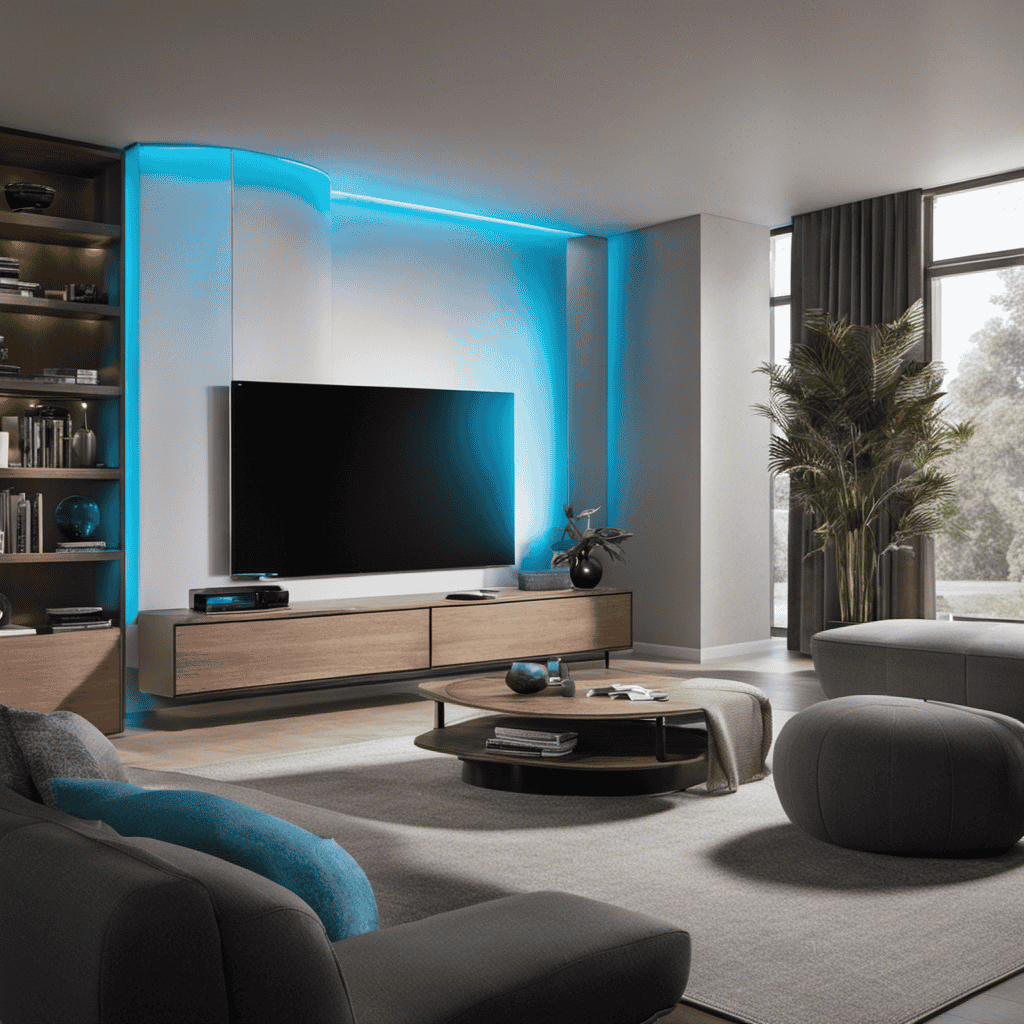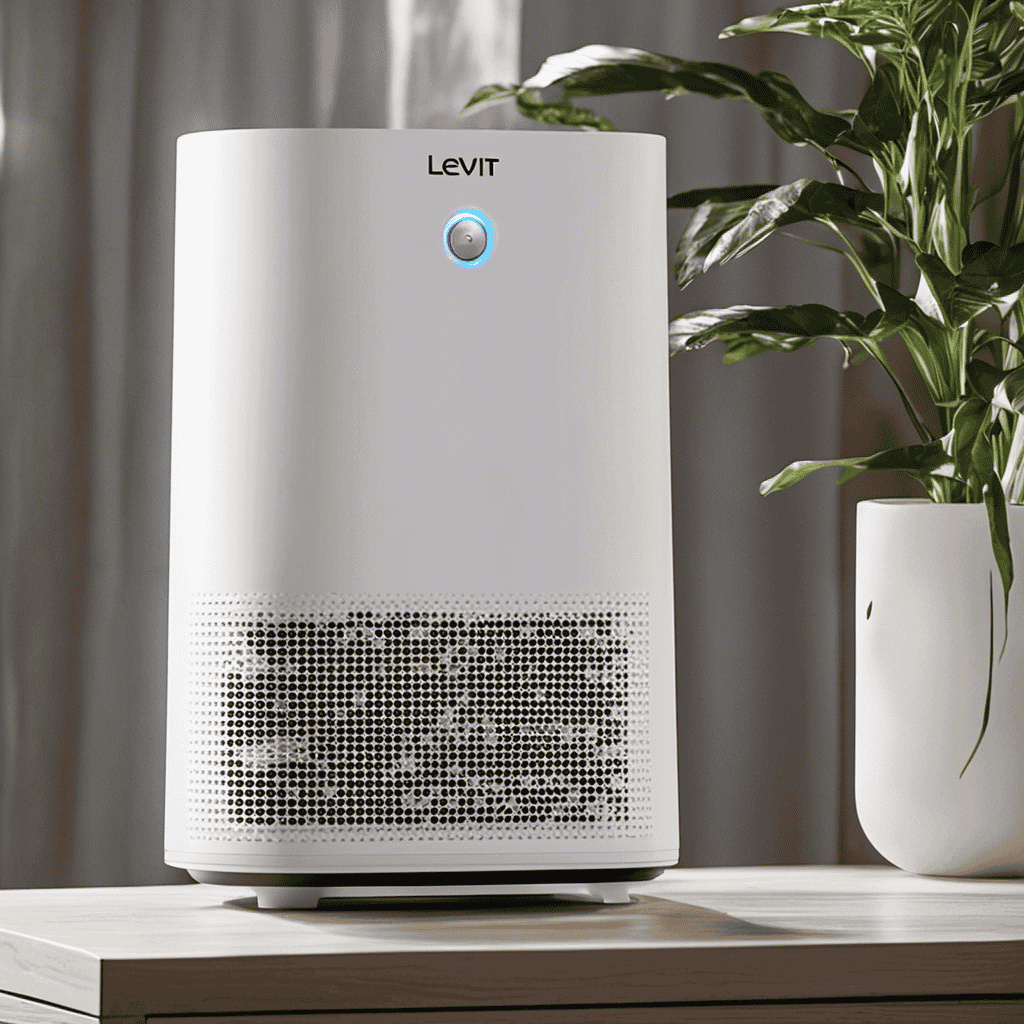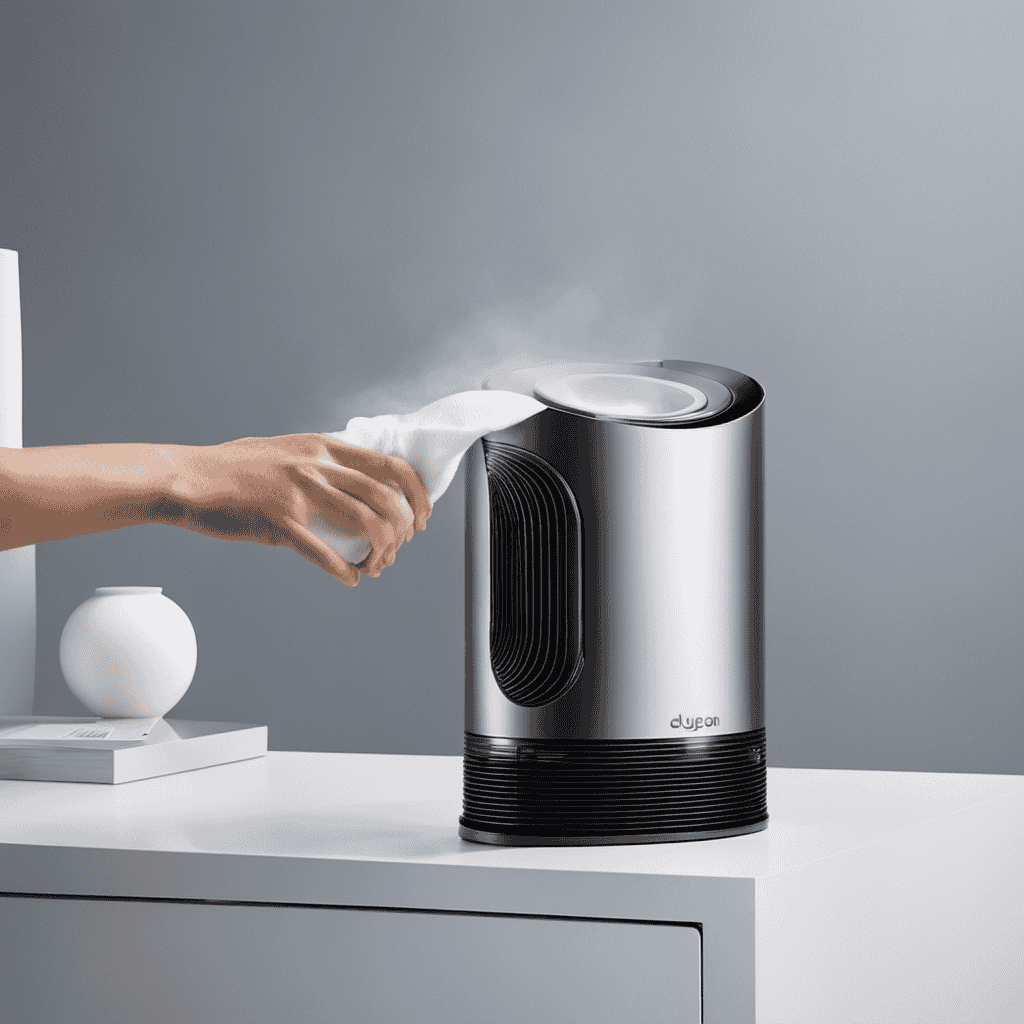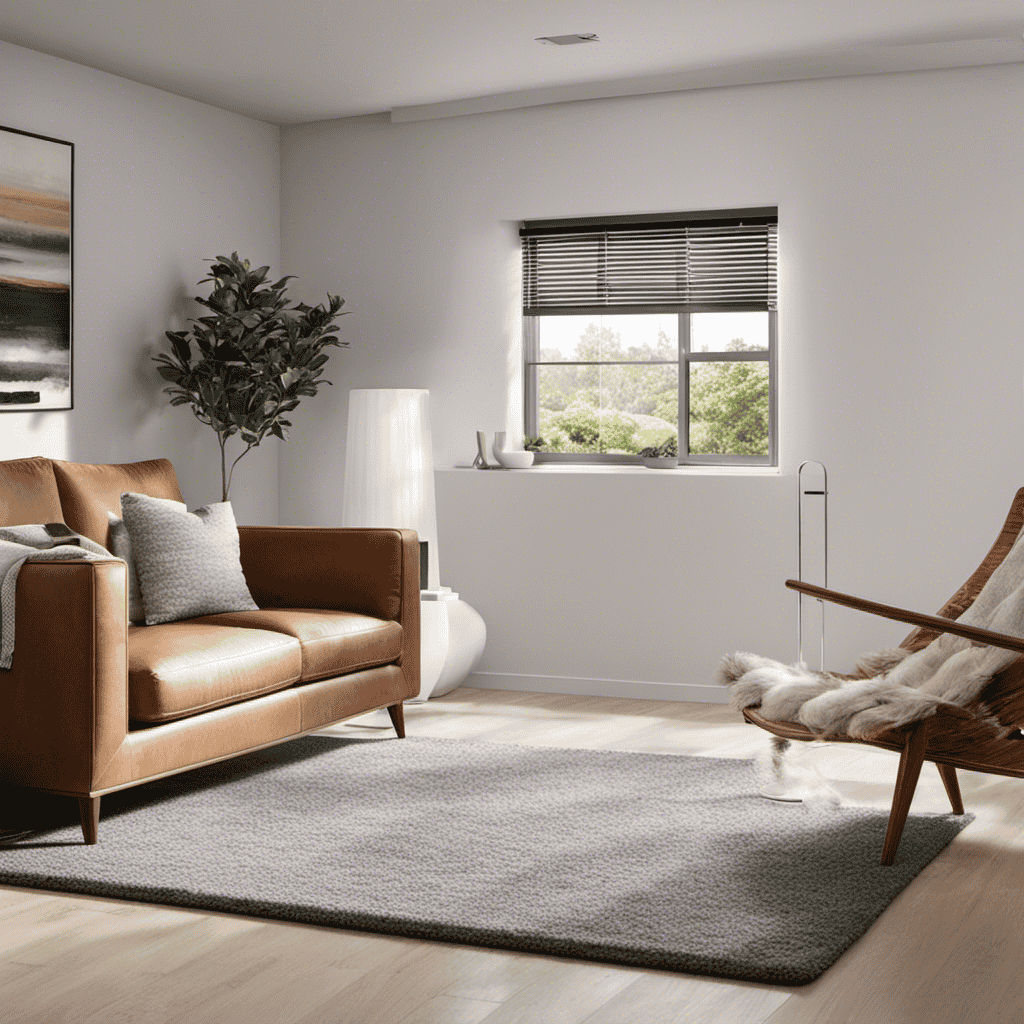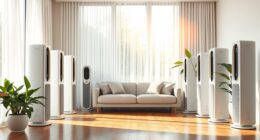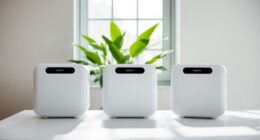Were you aware that indoor air may be up to five times more polluted than outdoor air?
With the increasing concerns about air quality, it’s important to understand how to effectively use an air purifier. In this article, I will guide you through the process of choosing, setting up, and maintaining an air purifier.
From understanding different filters to troubleshooting common issues, you’ll learn everything you need to know to ensure clean and fresh air in your home.
Let’s get started!
Key Takeaways
- Factors to consider when choosing an air purifier include room size, type of pollutants, and specific features.
- HEPA filters are important in capturing small particles and should be regularly replaced.
- Clean Air Delivery Rate (CADR) is used to determine the air cleaning speed of an air purifier.
- Regular filter replacement and unit cleaning are necessary for optimal performance and longevity.
Understanding the Basics of Air Purifiers
Understanding the basics of air purifiers is essential for knowing how to use them effectively. When choosing the right air purifier, it’s important to consider factors such as the size of the room, the type of pollutants you want to remove, and the specific features you need.
Look for air purifiers with HEPA filters, as they can effectively capture small particles like dust, pollen, and pet dander. Additionally, consider the CADR (Clean Air Delivery Rate) which indicates how quickly the purifier can clean the air in a specific size room.
To maintain and clean an air purifier, regularly check and replace the filters according to the manufacturer’s instructions. Clean the unit itself by wiping it down with a damp cloth and ensure proper ventilation to prevent the buildup of dust and debris.
Choosing the Right Air Purifier for Your Needs
When it comes to choosing the right air purifier for your needs, there are a few key points that you should consider.
First, you need to think about the size and coverage of the air purifier. This will determine how effectively it can clean the air in your space.
Second, you should look at the filter types available for the air purifier. Different filters target specific pollutants, so it’s important to choose one that will address your specific concerns.
Lastly, don’t forget to consider the noise level of the air purifier. Some models can be quite loud, which may be a concern if you plan to use it in a bedroom or office setting.
Size and Coverage
To effectively clean the air in your space, you’ll want to consider the size and coverage of the air purifier. Here are three important factors to consider:
-
Room size: Determine the square footage of the room you want to purify. This will help you choose an air purifier with the appropriate capacity to effectively clean the air in that space.
-
Purifying capacity: Look for the Clean Air Delivery Rate (CADR) of the air purifier. This indicates the volume of clean air the purifier can deliver per minute. Match the CADR with the size of your room to ensure efficient air purification.
-
Coverage area: Check the manufacturer’s specifications for the recommended coverage area of the air purifier. This will help you determine if the purifier can effectively clean the air in your room.
Considering these factors will ensure that you choose an air purifier that is suitable for your room size and has the purifying capacity to effectively clean the air.
Now let’s move on to the next section: filter types.
Filter Types
When choosing an air purifier, you’ll want to consider the different filter types available. There are several options to choose from, each with its own benefits and drawbacks.
The most common filter types include HEPA filters, activated carbon filters, and ionizers. HEPA filters are highly effective at removing small particles like dust, pollen, and pet dander from the air.
Activated carbon filters are great for eliminating odors and capturing volatile organic compounds (VOCs). Ionizers work by releasing negatively charged ions into the air, which attach to airborne particles and cause them to settle.
When choosing the right filter, it’s important to consider your specific needs and the air quality in your home. To maintain filter efficiency, make sure to regularly clean or replace the filter according to the manufacturer’s instructions.
Noise Level
The noise level of different air purifiers can vary based on the model and settings. When it comes to minimizing noise, here are three important things to consider:
-
Noise level ratings: Look for air purifiers with lower noise level ratings, typically measured in decibels (dB). A rating of 50 dB or below is considered quiet and suitable for most environments.
-
Fan speed settings: Adjusting the fan speed can help reduce noise levels. Lower settings generally produce less noise, but may also reduce the effectiveness of air purification.
-
Location: Placing the air purifier away from walls or furniture can help minimize noise. Additionally, avoiding positioning it near sources of noise, such as TVs or appliances, can further reduce disturbances.
If you experience excessive noise from your air purifier, troubleshooting steps may include checking for loose parts, cleaning or replacing filters, and ensuring proper assembly.
Once you have addressed any noise concerns, you can move on to unpacking and setting up your air purifier.
Unpacking and Setting Up Your Air Purifier
First, you’ll need to remove the air purifier from its packaging and find a suitable location to set it up. The unpacking process is straightforward – simply open the box and carefully remove all the components. Once you have everything out, refer to the setting up guide for instructions on how to assemble the air purifier. It’s important to find a location that allows proper air circulation and is away from any obstructions. To help you choose the right spot, consider the following factors:
| Factor | Consideration |
|---|---|
| Room Size | Ensure the air purifier is suitable for the size of the room. |
| Air Quality | Identify areas with poor air quality for optimal placement. |
| Noise Level | Place the air purifier away from sleeping areas or quiet spaces. |
Understanding the Different Filters in an Air Purifier
Understanding the different filters in an air purifier can help you make informed decisions about the type of filtration system that suits your needs. Here are three important filter types to consider:
-
HEPA Filters: These filters are highly efficient in removing microscopic particles such as dust, pollen, pet dander, and mold spores. They can capture particles as small as 0.3 microns, ensuring cleaner air for allergy sufferers.
-
Activated Carbon Filters: These filters are excellent at eliminating odors, gases, and volatile organic compounds (VOCs). They contain a bed of activated carbon that absorbs and traps these pollutants, leaving the air smelling fresh and clean.
-
UV-C Filters: These filters use ultraviolet light to kill bacteria, viruses, and other pathogens. They are particularly beneficial for those concerned about airborne illnesses and want to ensure a healthier environment.
Using air purifiers with these different filter types provides numerous benefits, such as reducing allergens, eliminating odors, and improving overall air quality. With the right filtration system, you can breathe easier and enjoy a healthier living space.
Installing and Replacing Filters in Your Air Purifier
When it comes to maintaining and replacing filters in your air purifier, there are a few key points to consider.
First, it’s important to understand the lifespan of your filters and when they need to be replaced. Regular maintenance is also crucial to ensure the effectiveness of your air purifier.
Additionally, choosing the right filters for your specific needs is essential in achieving optimal air quality.
Filter Lifespan and Maintenance
To maintain your air purifier’s efficiency, it’s important to regularly change the filters. Filters have a lifespan, and neglecting their maintenance can lead to decreased performance and poor air quality. Here are three crucial things to know about filter lifespan and maintenance:
-
Check the manufacturer’s recommendations: Each air purifier model has specific guidelines for filter lifespan. The recommended time frame can vary from a few months to a year, depending on factors like usage and air quality. Refer to the user manual or contact the manufacturer for accurate information.
-
Monitor filter condition: Regularly inspect your filters for signs of wear and tear, such as discoloration or clogging. If you notice a significant decrease in airflow or a foul odor, it’s time to replace the filters, even if they haven’t reached their recommended lifespan.
-
Follow proper maintenance procedures: When replacing filters, follow the manufacturer’s instructions carefully. This may involve turning off the unit, removing the old filters, and installing the new ones correctly. Regularly cleaning the exterior of the air purifier and ensuring proper airflow can also contribute to optimal filter lifespan and performance.
Choosing the Right Filters
Make sure you choose the right filters for optimal performance and clean air in your home. When it comes to air purifier maintenance, selecting the proper filter is crucial. There are different air purifier filter options available, each with its own unique features and benefits.
The first type of filter is a pre-filter, which captures larger particles like dust and pet hair. It helps to extend the lifespan of the main filter by preventing larger particles from clogging it.
Next, there are HEPA filters, which are highly efficient at removing tiny particles such as pollen, mold spores, and pet dander. These filters are ideal for individuals with allergies or asthma.
Activated carbon filters are another option, as they effectively remove odors, smoke, and harmful chemicals from the air. Some filters even combine HEPA and activated carbon technology for comprehensive filtration.
Lastly, some air purifiers offer washable filters, which can be cleaned and reused, saving you money in the long run. However, keep in mind that washable filters may not be as effective as replaceable ones.
To ensure optimal performance and clean air, it is important to regularly check and replace your air purifier filters as recommended by the manufacturer. Remember to consider your specific needs and the air quality in your home when choosing the right filters for your air purifier.
Adjusting the Settings on Your Air Purifier
You can easily adjust the settings on your air purifier to suit your needs. By maximizing performance and optimizing settings, you can ensure that your air purifier is working at its best to clean the air in your home. Here are three key settings to consider:
-
Fan Speed: Adjusting the fan speed allows you to control the airflow and noise level of your air purifier. For everyday use, a lower speed setting may be sufficient. However, if you have pets or suffer from allergies, a higher speed setting can help remove more allergens and pet dander from the air.
-
Timer: Setting a timer on your air purifier can help save energy and prolong the lifespan of the filters. You can schedule the air purifier to run for a certain duration, such as a few hours a day, or during specific times when you know the air quality may be worse, such as during cooking or cleaning.
-
Filter Replacement Indicator: Many air purifiers have a filter replacement indicator that alerts you when it’s time to change the filters. It’s important to follow these indicators to maintain the performance of your air purifier. Regularly replacing the filters ensures that your air purifier continues to effectively remove pollutants from the air.
Understanding the Air Quality Indicator on Your Air Purifier
Understanding the air quality indicator on your device is essential for monitoring the cleanliness of the air in your home.
The air quality indicator provides valuable information about the current state of the air and helps you make informed decisions about when to use your air purifier.
The indicator measures the level of pollutants in the air and categorizes it according to air quality standards. It uses a color-coded system, such as green for good air quality, yellow for moderate, and red for poor.
Interpreting air quality data is crucial for understanding when the air in your home needs to be cleaned. By regularly checking the air quality indicator, you can ensure that your air purifier is effectively removing pollutants and maintaining a healthy environment for you and your family.
Using the Timer Function on Your Air Purifier
Using the timer function on your air purifier is a convenient way to automatically set the device to run for a specific period of time. This feature is especially useful when you want the purifier to operate while you’re away or during specific hours of the day.
To make the most out of the timer function, follow these steps:
- Press the timer button on your air purifier.
- Use the arrow buttons to set the desired time duration.
- Press the timer button again to activate the timer.
By using the timer function, you can ensure that your air purifier runs efficiently and for the desired duration. This not only helps to maintain clean air in your space but also saves energy by avoiding unnecessary operation.
Maximizing the Effectiveness of Your Air Purifier
When it comes to maximizing the effectiveness of your air purifier, there are several key points to consider.
First, understanding the filter replacement frequency is crucial in ensuring that your air purifier continues to provide clean and fresh air.
Secondly, choosing the ideal room placement for your air purifier can greatly impact its performance, as it allows for better air circulation and coverage.
Lastly, regular maintenance and cleaning of your air purifier is essential in keeping it in optimal condition and ensuring its longevity.
Filter Replacement Frequency
Make sure you’re aware of how often to replace the filters in your air purifier. Proper filter maintenance is crucial for maintaining the effectiveness of your air purifier and extending the filter’s lifespan. Here are some key points to keep in mind:
-
Follow the manufacturer’s recommendations: Different air purifiers have different filter replacement schedules. It’s essential to check the user manual or consult the manufacturer’s website to determine the recommended frequency for your specific model.
-
Monitor the filter’s condition: Regularly inspect the filter for signs of wear and tear, such as discoloration or reduced airflow. If you notice any issues, it may be time to replace the filter, even if it hasn’t reached the recommended replacement interval.
-
Consider environmental factors: The frequency of filter replacement can vary depending on factors like air quality, pet dander, and smoking habits. If you live in a highly polluted area or have pets or smokers at home, you may need to replace the filters more frequently.
Ideal Room Placement
Placing your air purifier in an ideal location within the room can optimize its performance and effectiveness.
When determining the ideal room size for your air purifier, consider its Clean Air Delivery Rate (CADR) and the square footage of the room. Air purifiers are designed to filter and circulate air within a specific area, so it’s important to choose a size that matches your room’s dimensions.
The benefits of air purifiers are numerous. They remove pollutants such as dust, pet dander, and allergens, improving the air quality and reducing the risk of respiratory issues.
Maintenance and Cleaning
Regular maintenance and cleaning is essential to keep your air purifier functioning at its best. Here are some cleaning techniques and filter maintenance tips that will help you maintain a clean and efficient air purifier:
-
Regularly clean the exterior: Use a soft cloth and mild detergent to wipe down the exterior of the air purifier. Avoid using harsh chemicals or abrasive materials that could damage the surface.
-
Clean or replace filters: Check your air purifier’s user manual for instructions on how often to clean or replace the filters. Some filters can be washed, while others need to be replaced. Follow the manufacturer’s recommendations for optimal performance.
-
Vacuum the intake vents: Dust and debris can accumulate on the intake vents, affecting the air purifier’s efficiency. Use a vacuum cleaner with a brush attachment to gently clean the vents and remove any buildup.
Placing Your Air Purifier in the Right Location
To ensure optimal performance, it’s important to position your air purifier in the right location. By placing your air purifier in the correct spot, you can maximize its efficiency and enjoy the many benefits it offers.
Firstly, it’s essential to place your air purifier in a central location within the room to ensure proper air circulation. This allows the purifier to effectively capture and filter airborne pollutants, such as dust, pollen, and pet dander.
Additionally, positioning your air purifier away from obstructions, such as furniture or curtains, will prevent airflow restrictions and enable the purifier to work more efficiently.
Lastly, locating your air purifier near potential sources of pollutants, like kitchens or smoking areas, can help improve indoor air quality.
Now that you understand the importance of proper placement, let’s move on to maintaining and cleaning your air purifier.
Maintaining and Cleaning Your Air Purifier
When it comes to maintaining and cleaning your air purifier, two important aspects to consider are the filter replacement frequency and the cleaning methods for effectiveness.
The filter replacement frequency will depend on factors such as the type of filter used and the air quality in your environment. Regularly replacing the filters is crucial to ensure optimal performance of your air purifier.
Additionally, using the right cleaning methods for effectiveness is essential to remove dust, allergens, and other pollutants from the air, prolonging the lifespan of your purifier and improving the air quality in your space.
Filter Replacement Frequency
The filter should be changed every six months for optimal air purifier performance. Regular filter replacement is crucial to maintain the effectiveness of your air purifier and ensure the cleanest air possible. Here are three key reasons why you should adhere to this recommended cleaning frequency:
-
Improved Air Quality: A clean filter traps and removes more airborne particles, such as dust, pollen, and pet dander, resulting in cleaner and healthier air for you to breathe.
-
Energy Efficiency: A clogged or dirty filter forces the air purifier to work harder, increasing energy consumption and potentially leading to higher electricity bills.
-
Cost-Effectiveness: While filter replacement does incur a cost, neglecting to change it regularly can lead to reduced air purifier lifespan and potential damage, resulting in higher replacement costs in the long run.
By regularly replacing your air purifier filter, you can maintain optimal performance, improve air quality, save on energy costs, and prolong the lifespan of your device.
Now, let’s explore the various cleaning methods for maximum effectiveness.
Cleaning Methods for Effectiveness
Regularly cleaning your air purifier filter is essential for maintaining its effectiveness and ensuring the cleanest air possible. There are various cleaning techniques that can be used, depending on the type of filter your air purifier has. For a washable filter, you can simply rinse it with water and mild soap, making sure to thoroughly dry it before putting it back in the purifier. If your filter is not washable, you can use a vacuum cleaner with a brush attachment to remove dust and debris. Additionally, using compressed air can help remove stubborn particles. When choosing cleaning products, it is important to avoid using harsh chemicals that could damage the filter. Some recommended products for cleaning air purifier filters include white vinegar, baking soda, or specialized filter cleaning solutions. By regularly cleaning your air purifier filter, you can ensure that it continues to effectively remove pollutants from the air in your home.
Transition: Now that you know how to effectively clean your air purifier filter, it’s time to address another common issue that may arise – dealing with noise issues from your air purifier.
Dealing With Noise Issues From Your Air Purifier
To reduce noise from your air purifier, try placing it on a soft surface like a rug or carpet. This will help absorb any vibrations and prevent them from amplifying the noise.
Additionally, consider the following tips for dealing with air purifier noise:
-
Check for loose parts: Make sure all the components of your air purifier are securely fastened. Loose parts can cause rattling or vibrating noises.
-
Clean or replace filters: A dirty or clogged filter can cause the fan to work harder, resulting in increased noise. Regularly clean or replace your filters to maintain optimal performance.
-
Adjust fan speed: Some air purifiers have adjustable fan speeds. Lowering the fan speed can reduce noise levels while still providing effective air purification.
Understanding the Energy Consumption of Your Air Purifier
If you’re curious about how much energy your air purifier uses, you can check the manufacturer’s specifications or look for the ENERGY STAR label.
Understanding the energy consumption of your air purifier is important for energy efficiency and saving electricity. The manufacturer’s specifications will provide you with the power rating of the unit, usually indicated in watts or kilowatts. This information will give you a clear idea of how much electricity the air purifier consumes during operation.
Additionally, the ENERGY STAR label is a reliable indicator of energy efficiency. Air purifiers with this label have been tested and certified to meet strict energy efficiency standards. By choosing an ENERGY STAR certified air purifier, you can ensure that you are using a device that is both effective at cleaning the air and energy-efficient, helping you to save electricity and reduce your carbon footprint.
Troubleshooting Common Issues With Your Air Purifier
When troubleshooting common issues with your air purifier, check the power cord to ensure it’s securely plugged in.
Here are three other common air purifier malfunctions to keep in mind:
-
Clogged filters: Over time, the filters in your air purifier can become clogged with dust, allergens, and other particles. This can greatly affect the performance of your purifier and reduce its effectiveness in cleaning the air. Regularly inspect and clean or replace the filters as needed.
-
Fan or motor problems: If you notice that your air purifier isn’t producing sufficient airflow or making unusual noises, it may indicate a problem with the fan or motor. In this case, it’s best to consult the manufacturer’s instructions or contact customer support for assistance.
-
Sensor issues: Some air purifiers have built-in sensors to detect air quality and automatically adjust settings. If these sensors aren’t functioning properly, it can lead to inaccurate readings and inefficient operation. Check the sensor settings and ensure they’re calibrated correctly.
Extending the Lifespan of Your Air Purifier
Regular maintenance and cleaning can help extend the lifespan of your air purifier. To maximize efficiency and increase filter lifespan, it is important to follow a few key steps.
First, make sure to regularly check and clean the pre-filter. This will help prevent larger particles from clogging the main filter, allowing it to function optimally.
Additionally, it is crucial to replace the air purifier’s filters according to the manufacturer’s recommendations. This will ensure that the air purifier continues to effectively remove pollutants from the air.
Furthermore, be mindful of the air purifier’s placement. Avoid placing it near sources of dust or smoke, as this can lead to faster filter saturation.
Finally, consider using a vacuum cleaner with a HEPA filter to clean the surrounding area, reducing the amount of particles that may enter the air purifier.
Frequently Asked Questions
Can an Air Purifier Completely Eliminate All Allergens and Pollutants From the Air?
An air purifier can effectively reduce allergens and pollutants in the air, but it may not eliminate them completely. Regular maintenance, such as cleaning or replacing filters, is crucial to ensure optimal performance.
How Often Should I Replace the Filters in My Air Purifier?
When it comes to replacing the filters in my air purifier, I make sure to do it regularly. The frequency depends on the manufacturer’s recommendations and the signs of a dirty filter, like reduced airflow or a musty odor.
Can I Use an Air Purifier in Multiple Rooms of My House?
Yes, you can use an air purifier in multiple rooms of your house. The benefits of using an air purifier in multiple rooms include improved air quality and reduced allergens. However, it is important to choose the right size air purifier for each room.
Is It Safe to Leave My Air Purifier on All Night While I Sleep?
Leaving my air purifier on all night while I sleep is safe. Despite the hyperbolic claim that it will transform my room into a paradise, the low noise level and benefits of clean air make it worth it.
Can an Air Purifier Help With Odors and Smells in My Home?
Yes, an air purifier can help eliminate odors and smells in your home. Regular air purifier maintenance ensures optimal performance. The benefits of using an air purifier include improved indoor air quality and a fresher living environment.
Are there specific steps or guidelines for using an air purifier effectively?
Yes, there are specific steps and guidelines to follow when using an air purifier effectively. A using an air purifier tutorial can help you understand how to properly place the purifier, maintain it, and determine the right settings to ensure optimal air quality in your home.
Conclusion
So there you have it, folks! Using an air purifier is like having a magical device that transforms your home into a pristine sanctuary.
With its powerful filters and noise-reducing technology, it’s like having your very own personal air guardian.
And the best part? It’s so easy to use and maintain, you’ll wonder how you ever lived without it.
So go ahead, take the leap and bring home an air purifier. Your lungs will thank you, and you’ll wonder how you ever survived without such a remarkable machine.
